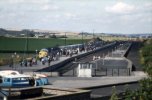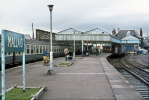Probably depends on what the typical timetable was. Would imagine that the station was probably busiest on a Saturday changeover day with departing holiday camp patrons boarding the various morning departures, and then the following week's holidaymakers arriving from maybe Saturday midday onwards. A further question might be how early and late in the season that the Butlin's holiday camp was actually open for business.
Looking at my North Eastern Region timetable for June to September 1953 shows there being no Monday to Friday service (indeed the station doesn't even appear in the timetable on those days!) nor is there a Sunday service. On Saturdays however it shows departures from the Camp at 0855 (to Newcastle), 0920 (to King's Norton), 0932 (to York), 0950 (to Sheffield Victoria), 1035 (to King's Cross*), 1137 (to Leeds) and 1222 (to Manchester Exchange). All departures went south via Bridlington.
Arriving at the Camp you have 1149 (from Leeds), 1229 (from York), 1253 (from Manchester Exchange), 1331 (from Sheffield Victoria), 1343 (from King's Cross^), 1352 (from Worcester Shrub Hill), 1445 (from Newcastle) and 1707 (from York). All arrivals came from the south via Bridlington.
Many of the above are marked as only running during the height of summer. The end of June to the first week of September typically. Interestingly the service to King's Cross appears to run through the whole timetable whereas the service from appears to change to a Hull service on the last Saturday in the timetables period.
Obviously I don't have any extras that may or may not have run on top of what was in the more long term plan represented by the timetable.
*calling at Bridlington then non-stop to Doncaster before continuing to Grantham and King's Cross arriving at 1607 with refreshment car throughout.
^departing King's Cross at 0820 and calling at Hitchin, Peterborough, Doncaster then non-stop to Bridlington again with refreshment car throughout.


